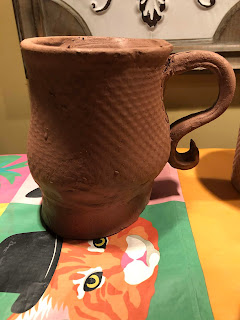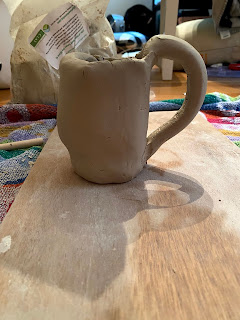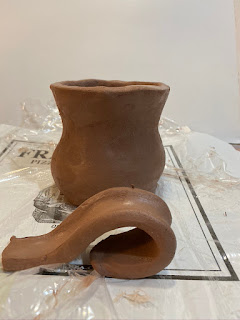Wednesday, April 29, 2020
Monday, April 27, 2020
Last Week!
One more project... This is your free choice... Or if you'd like try this footed bowl
Remember to create a Google Drive folder and share it with me using jnevins@albertus.edu
Posts here until Monday morning will count towards attendance...
Have fun!
This simple technique produces an amazing mini folded bowl 🙂
Perfect if you don’t own a pottery wheel.
Step 1) Roll out a slab, and make a square.
Step 2) Make your design in the square slab
Step 3) Cut away triangles from the corners
Step 4) Round off the edges, lift up the corners and score and slip them together.
Step 5) Add a foot to your new bowl
From https://ceramic.school/blog/page/8/ Scroll down...
Remember to create a Google Drive folder and share it with me using jnevins@albertus.edu
Posts here until Monday morning will count towards attendance...
Have fun!
Sunday, April 26, 2020
Friday, April 24, 2020
Response
At the beginning of time, art was the first history of everyone's culture. It all started from the Earth. Clay is a form of soil, so back then, people had to search hard and long for the right clay. As of now, the clay is already fresh and perfect in a bag for people. As of in ceramics class right now, I do not have a problem finding clay because it begins in a bag. Clay is essential because its the central part of creating the ceramic piece. Clay is art; it is a form of peace and creativity. As making it and forming the clay into some artwork, it takes time and dedication. As working on the artwork, it becomes relaxing and a way of life. It is making these creations show the views of the artist's style and how they feel when making it. Nowadays, as we make pots, we do not get the full experience that our ancestors had, they put labor in their pots. Compared to us, we only take it out of a bag in a small room. Making pots this way is not the most straightforward way of connecting to the Earth and our ancestors. However, the sense of syles that we use connects us to long lost traditions.
Wednesday, April 22, 2020
Tuesday, April 21, 2020
response to video
I really enjoyed watching the process from start to finish. The video gave a better perspective on the art of clay. Watching the native gather the clay from the ground was awesome to see. It brought appreciation that we have it accessible from a bag. The native was able to create beautiful clay pots with minimal tools. The native was even able to complete the process of glazing and firing. As we work without the art studio, its inspiring to see that we still have the ability to make great work at home! The video shows that patience and the skills work that has been used from 100 of years ago. It shows how these skills started from using creativity and working with the things that are around us. It is nice to see the tradition is still being past on and that clay can last a long time. In the video I was able to recognize some of the skills that have been taught to us this semester.
Monday, April 20, 2020
Response to video
Seeing how he needed to go find the clay in the middle of the desert and dig it up was so fascinating to me because we just think it comes from a bag. I have never thought of the hard work that must go into finding the clay and gathering it. This relates to everything we have done in class because he is only using his hands the things around him to form his clay and make a pot. We use another form of something to try and help guide us as well. But, he has done everything by hand and it was really amazing to watch how he formed it and was able to make a pot from dry clay that he had found in the desert.
Response
For those of us in ceramics class, the clay starts off in a bag. We don’t think much about where it comes from or how it is made. This video, however, shows that ceramics really do come right from the earth. The creation of the clay is just as important as the formation of the ceramic piece. While there is a lot of work that goes into the creation of the pot, many of the motions are repeated over and over. In this way, forming a pot can be meditative and relaxing. It is also important to note that his creation of the pots is a way of keeping the traditional way of making pots alive. Making pots this way is not only a way of connecting to the earth around us but also a way of connecting to our past and our almost-lost traditions.
Sunday, April 19, 2020
Response to Video
When watching the video I notice how similar his technique is to ours. We used a mold and filled the inside and he used a pot as his mold and put clay around it. He adds more clay by creating coils and adding them onto the edges and blending them in with the paddle.
It is hard to think about how these clay pots were made hundreds of years ago without all the tools we have and a kiln. Everything comes easily as we can buy clay ready to use. They had to find clay, often in deserts and grind the dried clay into a fine powder and tempered with sand, volcanic ash or crushed pot shards. I now can see how much work goes into the process of making clay naturally.
He uses tools like sticks to dig up the clay and only carries what he will need for that pot. He then used a rock and a paddle to strengthen the pot. It showed how creative he, and the ancient potters, had to be to create these pots. He starts to use a similar approach that we did, using a mold in the sand to hold to round bottom, while he builds up the sides.
In order to paint the pot, he had to find iron oxide in the desert and grind that. He does everything in a way that may have been done by the ancient potters. He does not use a kiln or even matches for his fire and uses brushes made of human hair just like they would have.
He does all of this to keep the tradition alive, and that is why he paints the pots with traditional patterns. I find it amazing that we could make these pots in one day and potentially have them completely done within a week, while his process seems to take a lot longer, he lets his pots dry for 4-5 days before painting. We do things out of convenience and entertainment while he does it for the history that is involved and keeping it alive.
It is hard to think about how these clay pots were made hundreds of years ago without all the tools we have and a kiln. Everything comes easily as we can buy clay ready to use. They had to find clay, often in deserts and grind the dried clay into a fine powder and tempered with sand, volcanic ash or crushed pot shards. I now can see how much work goes into the process of making clay naturally.
He uses tools like sticks to dig up the clay and only carries what he will need for that pot. He then used a rock and a paddle to strengthen the pot. It showed how creative he, and the ancient potters, had to be to create these pots. He starts to use a similar approach that we did, using a mold in the sand to hold to round bottom, while he builds up the sides.
In order to paint the pot, he had to find iron oxide in the desert and grind that. He does everything in a way that may have been done by the ancient potters. He does not use a kiln or even matches for his fire and uses brushes made of human hair just like they would have.
He does all of this to keep the tradition alive, and that is why he paints the pots with traditional patterns. I find it amazing that we could make these pots in one day and potentially have them completely done within a week, while his process seems to take a lot longer, he lets his pots dry for 4-5 days before painting. We do things out of convenience and entertainment while he does it for the history that is involved and keeping it alive.
Response to Tony Soares Video
I found this video very interesting especially seeing how much work went into the whole process of Tony creating his pot, starting from him making his own clay by digging it up, grinding it out and then mixing just the right amount of temper. I never thought about the process of where the clay we work with comes from. Tony showed a lot of talent and extreme patience. I was definitely jealous of how perfect his work was and how he never made any mistakes at all. He was able to keep it smooth and maintained as he kept adding more coils to the pot. It was also nice to see him do this project because it is so similar to the pots we made in class, except that Tony made his with just a paddle and stone and his was much bigger than the ones we did. Having done this in a smaller version inside a classroom with modern tools, made me appreciate Tony's skill at doing it the way it was done 5000 years ago outside on the ground. It was also interesting to see him mix his own paint using natural materials and then fire it in the ground using a fire pit. I also enjoyed the video of the students in the class making the Mohave pottery. It was nice to see that they were trying to keep their culture and traditions alive by creating pottery the way their ancestors did hundreds of years ago. After losing so much of their culture it is good to see them keeping it alive and passing it on.
Friday, April 17, 2020
Documentary Response
Native Clays gave a better understanding as to why pottery is such a beautiful form of art. The connection with the earth when creating a pot is quite powerful. I was not grasping that connection until I watched how he gathered the materials. I appreciated how the documentary expressed the connection between the earth and pottery. I believe it to be an important piece to understand when creating a piece. The experience becomes more powerful and you become more connected to what you are creating.
The technique that was used during the documentary is the same we use in class. It gave me a better visual on how to use the paddle to mold the clay the way I want. I think now that I have seen this I would be more patient when creating my pieces because I saw the patience he had when working and molding the clay. I understand now that it is a process and the building needs to be treated as a delicate process.
The technique that was used during the documentary is the same we use in class. It gave me a better visual on how to use the paddle to mold the clay the way I want. I think now that I have seen this I would be more patient when creating my pieces because I saw the patience he had when working and molding the clay. I understand now that it is a process and the building needs to be treated as a delicate process.
Thursday, April 16, 2020
Response to Video
I was researching Native American Pottery and Totems to teach as a lesson to a group of 6th and 7th graders. I stumbled upon this video and was taken aback by the amount of things that we take for granted or forget. Opening a bag in the studio, I often forget that the contents of the bag are part of the earth. It was absolutely incredible to watch Tony Soares dig up earth and create clay. A reason that I love working with clay is because the methods that we still use today date back thousands of years. The process connects us to the past and people around the world.Clay can connect you to different areas of the world and different values. This is such a time consuming practice, that Tony has mastered. In our class, we worked using molds; however, Tony was using a sunken area of sand. He has simply mastered the technique that people used so many years ago. It is amazing to see him use similar tools to us, such as the paddle. There is something so eerie and spiritual in watching a pot be created in this way. It is amazing that the process of working with clay does not change much over time. We also used a mold for our first project. We used the coil method as he did. We also smoothed the lines and used the paddle to work with the clay. Our projects look just like miniature versions of his. It is so interesting to connect the work that we do in our class to practices thousands of years old around the world.
Wednesday, April 15, 2020
Tuesday, April 14, 2020
Work for this week!
As you may recall, I explained that our first project of the semester... making a series of 3 round pots starting with the plaster form was taken from indigenous practice from all over the world and from ancient times.
As a project for this week, I would like you to watch this video of Native American, Tony Soares working on one of his large storage containers. Find a quiet spot and settle in with headphones and open your heart to the quiet pace of what is happening.
Write a short reflection piece on the worth of this whole approach and how it relates to what we have done. For some insight about the language native potters might use, here is an 8 min follow up video of Tony leading a workshop 10 years later... but more importantly, the words of the participants are key to the lesson of .... why.
Thanks Jane for sending me the link!
Some comments under the video
"A true artist, no fakery. The ancient art of hand and eye."
"I like how his grandma told him to go find it."
"Mesmerizing and taught me to be more patient with the creative process."
"I want to be like this man.. Calm, patient, doing pottery for hours in a peaceful place."
"I have the worst crush now! Not sure if it's for the pot or the potter, they are both so handsome"... Amy Havens
Short follow up video:
As a project for this week, I would like you to watch this video of Native American, Tony Soares working on one of his large storage containers. Find a quiet spot and settle in with headphones and open your heart to the quiet pace of what is happening.
Write a short reflection piece on the worth of this whole approach and how it relates to what we have done. For some insight about the language native potters might use, here is an 8 min follow up video of Tony leading a workshop 10 years later... but more importantly, the words of the participants are key to the lesson of .... why.
Thanks Jane for sending me the link!
Some comments under the video
"A true artist, no fakery. The ancient art of hand and eye."
"I like how his grandma told him to go find it."
"Mesmerizing and taught me to be more patient with the creative process."
"I want to be like this man.. Calm, patient, doing pottery for hours in a peaceful place."
"I have the worst crush now! Not sure if it's for the pot or the potter, they are both so handsome"... Amy Havens
Short follow up video:
Monday, April 13, 2020
Sunday, April 12, 2020
Friday, April 10, 2020
Thursday, April 9, 2020
Subscribe to:
Comments (Atom)













































